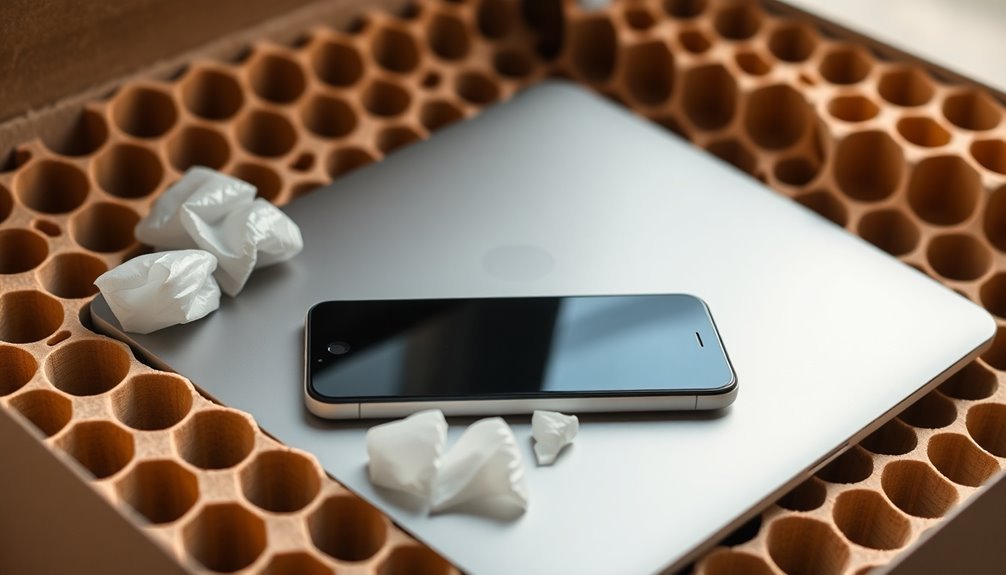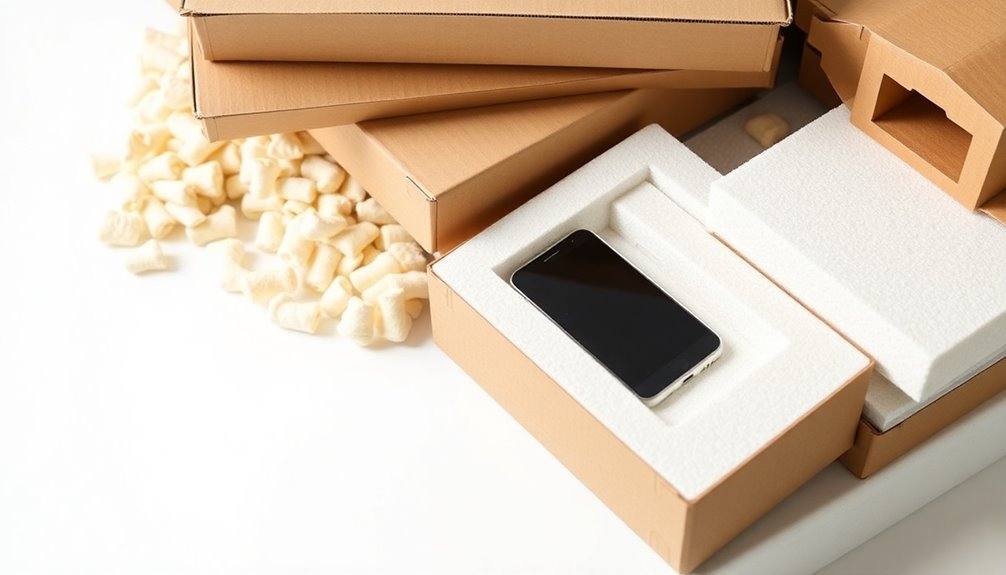You'll find excellent protection for shipping electronics with these five eco-conscious alternatives. Biodegradable anti-static bags made from corn and potato starch eliminate petroleum while providing superior static protection. Eco-friendly foam cushioning, crafted from cornstarch-based materials, offers robust shock absorption and thermal insulation. Sustainable void fill options like kraft paper and honeycomb structures deliver reliable protection while remaining fully recyclable. Double-layer electronic mailer systems combine rigid and flexible materials for maximum defense. Static-dissipative paper packaging, such as EcoSonic ESD, integrates vapor phase corrosion inhibitors for thorough protection. These modern solutions represent just the beginning of sustainable electronics shipping innovations.
Biodegradable Anti-Static Shipping Bags

Three key innovations in biodegradable anti-static shipping bags have revolutionized electronics packaging. First, they're now made entirely from renewable resources like corn and potato starch, eliminating the need for petroleum-based materials.
Second, they provide superior static protection while being 100% environmentally friendly. These bags utilize heat sealable construction for maximum protection during shipping.
Third, they offer excellent moisture resistance while maintaining complete biodegradability in water.
You'll find these bags particularly effective for shipping static-sensitive electronics, as they dissipate static electricity efficiently while keeping your products clean and dry. They're designed to meet specific packaging requirements and can be customized to your needs. What's more, you're likely to see cost savings since these bags can be recycled and reused.
Before implementing biodegradable anti-static bags in your shipping process, you'll need to evaluate several factors. Check your local regulations on biodegradable packaging to comply. Compare the shelf life and performance metrics against traditional options, and evaluate how they'll impact your supply chain logistics.
You'll also want to assess the overall cost-effectiveness, though many businesses find them more economical than conventional alternatives while appealing to environmentally conscious customers.
Eco-Friendly Foam Cushioning Solutions
The latest innovations in eco-friendly foam cushioning have transformed electronics packaging with sustainable alternatives to traditional materials. You'll find options like Ethafoam that provide superior impact protection while being divertible to waste-to-energy facilities instead of landfills.
When you're shipping electronic components, you can choose from various specialized solutions. Anti-static foams effectively dissipate electrostatic charges, while fabricated foams offer excellent thermal insulation and vibration dampening. Cost-effective shipping is achieved through foam packaging's lightweight nature, reducing overall transportation expenses.
For irregularly shaped items, expanding foams conform to each product's unique contours, minimizing movement during transit.
You don't have to compromise sustainability for protection. Today's eco-friendly alternatives include recyclable foam mailers made from plant-based materials and biodegradable options using wheat or cornstarch.
If you're looking for reusable solutions, custom-designed foam packaging can be engineered for multiple uses, reducing single-use plastic waste.
For maximum protection, you'll want to evaluate combining different foam types based on your specific needs. Surface protection foams prevent scratches, while corrugated bubble provides edge crush protection.
All these solutions comply with industry standards while maintaining your commitment to environmental responsibility.
Sustainable Protective Void Fill

Selecting sustainable void fill solutions can dramatically reduce your environmental impact while maintaining superior product protection during shipping.
When packaging electronics, you'll find several eco-friendly options that offer excellent cushioning properties without compromising on performance. Using these materials can lead to waste disposal savings of up to 30%.
Consider kraft paper and honeycomb void fill for your electronics packaging needs. These recycled materials provide reliable protection while being fully recyclable.
You can also use corrugated cushioning wrap, which combines paper and air to create effective shock absorption for small to medium-sized devices.
For enhanced protection of delicate components, try expandable cellulose wadding or single-face corrugated rolls. These materials adapt well to oddly shaped electronics and offer superior force insulation.
If you're shipping moisture-sensitive equipment, cellulose wadding's absorbent properties provide an added layer of protection.
To determine the most effective solution, you'll want to test different options based on your specific shipping conditions. Focus on materials that offer both adequate protection and sustainability.
Work with packaging experts to optimize your void fill strategy, ensuring you're using the right amount of material while maintaining maximum protection for your electronic shipments.
Double-Layer Electronic Mailer Systems
Designed for maximum protection, double-layer electronic mailer systems combine rigid and flexible materials to create a superior defense against shipping damage. You'll find these systems particularly effective for shipping sensitive electronics, as they utilize materials like epoxy resin, silicone rubber, and metal matrix composites to guarantee both moisture resistance and thermal stability. Similar to how double encryption adds layers of data security, these packaging systems provide multiple barriers of physical protection.
| Material Type | Protection Level | Best Applications |
|---|---|---|
| Epoxy/Silicone | High Moisture | PCB Components |
| Metal Matrix | High Thermal | Heat-Sensitive Parts |
| FR-4 Fiberglass | High Impact | Circuit Boards |
| Aluminum/Copper | Medium-High | Light Electronics |
| Steel Based | Maximum | Military Grade |
When you're shipping high-value electronic components, you'll appreciate how double-layer packaging provides enhanced security against physical damage while maintaining superior insulation properties. This system's proven effectiveness in military and aerospace applications demonstrates its reliability for extreme conditions. You can rely on double-layer packaging for industrial electronics and devices operating in harsh environments, as it's specifically designed to handle thermal fluctuations and mechanical stresses. By choosing double-layer electronic mailers, you're guaranteeing compliance with electronic packaging standards while gaining the flexibility to select materials that match your specific protection requirements.
Static-Dissipative Paper Packaging Options

While double-layer systems offer robust physical protection, static electricity poses another significant threat to electronic components during shipping. Static-dissipative paper packaging, like EcoSonic ESD Paper, provides an effective solution that combines static protection with environmental sustainability.
You'll find that this specialized paper includes both a static-dissipative coating and a vapor phase corrosion inhibitor (VCI/VpCI), giving you dual protection for your electronics. The coating eliminates static buildup, meeting critical industry standards, while the VCI forms a protective molecular layer on metal surfaces to prevent corrosion. The paper remains thermally stable up to 392°F, ensuring protection even in extreme temperature conditions.
When you're looking for versatile packaging options, you can use static-dissipative paper to create instant protected workspaces or wrap it around electronics to form secure enclosures.
You'll save money compared to plastic alternatives while supporting environmental sustainability, as the paper is recyclable and made from renewable resources.
Unlike traditional plastic packaging or thermoformed options, you can easily customize static-dissipative paper to fit specific electronics through simple wrapping and taping. It's particularly useful when you need to create multi-layer packaging solutions or prepare static-safe workbenches for electronics assembly and inspection.
Frequently Asked Questions
How Long Do Anti-Static Properties Remain Effective in Biodegradable Packaging Materials?
Your biodegradable packaging's anti-static properties will remain effective until the material completely breaks down. In commercial composting environments, this means they'll last for weeks to months, depending on the specific product used.
What Temperature Ranges Can Eco-Friendly Protective Packaging Materials Safely Withstand?
You'll find eco-friendly packaging materials can handle diverse temperatures: PE foam (-100°C to 80°C), PU foam (-200°C to 100°C), mycelium (0°C to 50°C), aluminum (-20°C to 150°C), and PCMs (-20°C to 40°C).
Are Sustainable Packaging Alternatives More Expensive Than Traditional Protective Materials?
Yes, you'll find sustainable packaging typically costs more upfront than traditional materials. However, you can offset these expenses through long-term savings in waste management, improved brand reputation, and reduced environmental compliance costs.
How Do Weather Conditions Affect the Performance of Biodegradable Shipping Materials?
You'll find that weather substantially impacts biodegradable shipping materials. High humidity weakens their structure, extreme temperatures cause degradation, rain leads to disintegration, and strong winds can damage these eco-friendly packaging options.
Can Recyclable Protective Packaging Be Reused Multiple Times for Shipping Electronics?
Yes, you can reuse recyclable protective packaging multiple times for electronics shipping. You'll find materials like corrugated cardboard and plastic sheets maintain their protective qualities while saving money and reducing environmental impact.
In Summary
You'll find these five eco-conscious packaging solutions offer reliable protection for your electronics while reducing environmental impact. Whether you choose biodegradable bags, sustainable foam, or static-dissipative paper, you're making a smart choice for both product safety and planet-friendly shipping. Start implementing these alternatives today, and you'll contribute to a more sustainable future in electronics packaging without compromising protection.





Leave a Reply